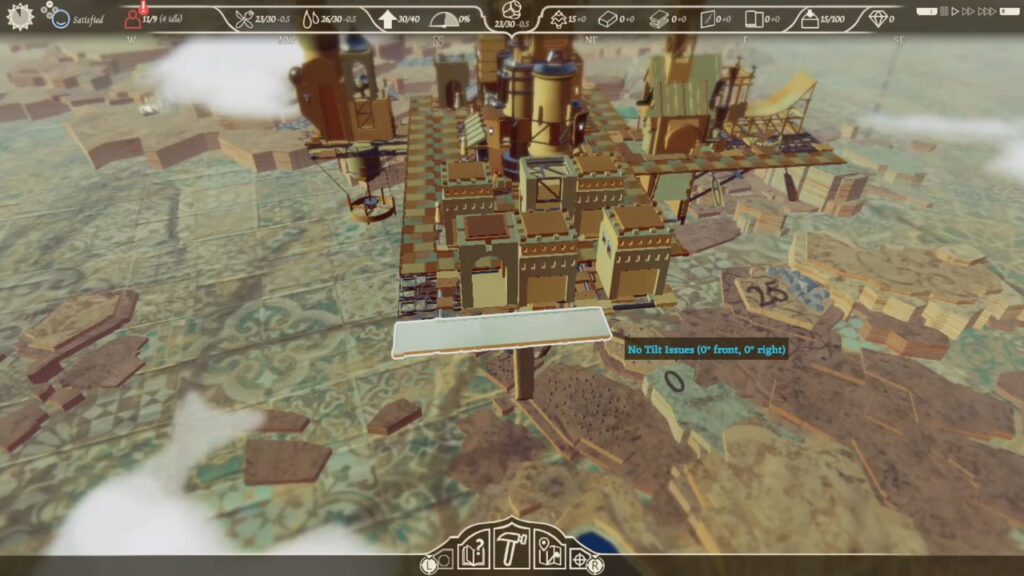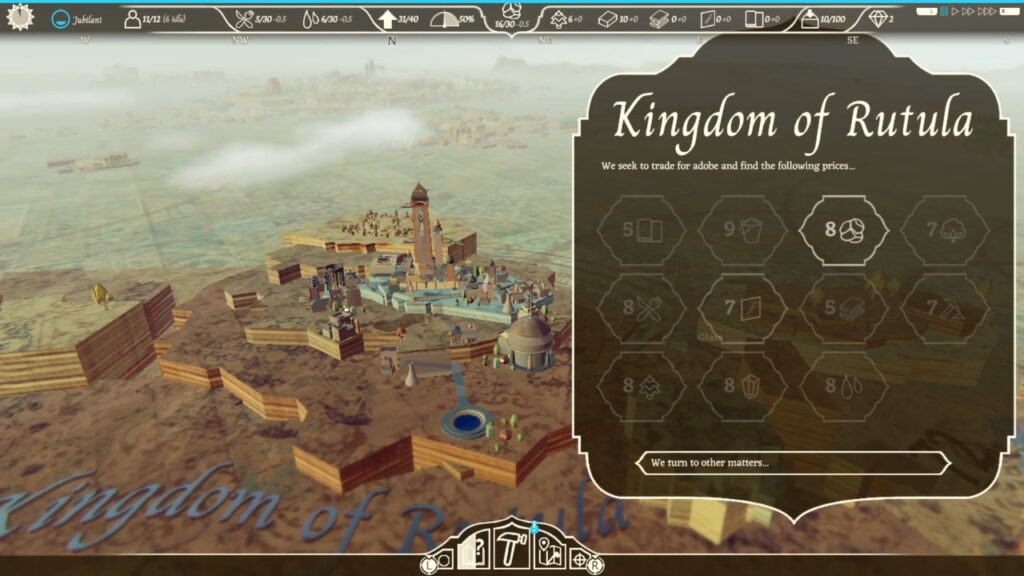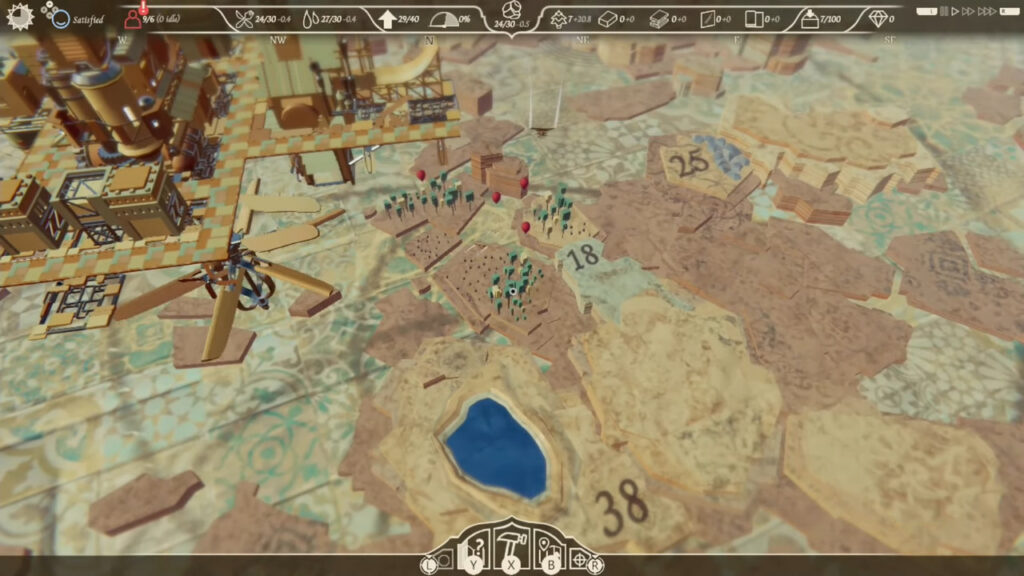
Developer: The Wandering Band LLC
Publisher: Freedom Games
Platform: PC, PS4, PS5, Xbox One, Xbox Series X|S, Switch
Tested on: Switch
Airborne Kingdom – Review
Almost a year after indie developer The Wandering Band LLC released their city-building sim Airborne Kingdom on PC, the game floats onto consoles. Providing a unique and original take on the classic city-building sim genre, Airborne Kingdom certainly looks interesting. Always eager to reach new heights, we decided to take a visit to this monarchy above the clouds to discover whether or not it’s worth visiting.
Story
Although Airborne Kingdom’s main campaign is somewhat story-driven, the actual narrative doesn’t really come through. Things start out good enough through the opening cutscene, but fizzle out after that. The game features no on-screen characters, instead relaying a significant part of the story details through pop-up text boxes. The campaign tells the tale of a legendary flying kingdom from a bygone age that brought prosperity to the lands it visited. When the original airborne kingdom vanished, the lands below fell into strife and suffered from poverty. Fortunately, the blueprints of the Ancients have been found and now a new airborne kingdom is set to take to the skies, uniting the lands below and bringing peace and prosperity once again.
Graphics
The Wandering Band made an unusual choice with Airborne Kingdom’s visuals, marrying steampunk aesthetics with traditional Arabian ones. The game goes for an abstract representation of the lands below the floating world, with valleys and plains appearing like decorative tiles and mountain ranges looking like layered flat stones. The visuals create a unique atmosphere, which works well enough. Unfortunately, the Switch version suffers from a lower resolution compared to the footage we saw on other platforms. 3D models tend to show jagged edges and the draw distance is poor. What doesn’t help here either is the ridiculously small text size. Finally, moving around the camera feels slow and janky. These issues seem to be exclusive to the Switch version. Other console versions don’t suffer from the issues with jagged edges and lower resolution, though the camera controls still aren’t optimal either.
Sound
Airborne Kingdom continues to embrace the Arabian aesthetic through its music, which sounds like it came straight from the Middle East. It fits the game’s overall atmosphere, though it does start to feel repetitive after a prolonged play session. The opening cutscene is narrated and the voice actor does a great job in making the prophecy of the main story sound suitably epic. Sound effects are good as well, and the overall audio quality of the game is fantastic.
Gameplay
Despite the unconventional setting, Airborne Kingdom is essentially a city-building sim game. As you play through the game’s main campaign, your aim is to construct an aerial steampunk city of your own. The very nature of building a city in the sky means that certain mechanics need to be approached in a different way, such as ensuring any additions to the city are connected to the main structure rather than floating around freely. In a similar vein, resource gathering requires a different approach compared to more traditional sim games. By implementing core mechanics with this outside-the-box mindset, The Wandering Band provides players with a clever twist on an established genre, though the execution leaves a few things to be desired.
Getting your city off the ground is easier than you’d imagine, as you start out with a simple town center already hovering above the fertile lands below. Of course, you’re going to want to expand this budding community. To do so, you’ll need to go through the same motions as any other city building sim: gather resources to expand your city, build new structures that gain you access to new features and allow you to research upgrades and further new structures. The core gameplay is easy enough to wrap your mind around and the “twists” feel natural as well. You’ll need to organize expeditions to the world below to gather resources -a process that can eventually be automated. Once resources below your current location have been exhausted, you can simply pilot your city elsewhere and start harvesting again. You’ll also have to keep an eye on how balanced your city is, as adding new structures tends to shift the city’s weight. Thankfully, things like wings and balloons can ensure you keep your city level.
Airborne Kingdom is filled with clever ideas like this, but we did find that the core gameplay experience lacked some depth. Resources are easy to come by and we never found ourselves worried about running out during our time with the campaign. Once a structure is completed, it just does its thing and you don’t have to worry about upkeep. Instead, the focus of the game lies mostly on expanding your city. Even the game’s quests are built around expansion and resource management. We could’ve used a little more gameplay variety, because as it stands, Airborne Kingdom becomes a very repetitive experience after a few hours. Even the game’s creative mode, which strips away a lot of the resource management, feels like it could have been fleshed out a little more. Building the city of your dreams sounds good in theory, but there is a lack of incentive to do so.
We would’ve liked to have seen city upkeep mechanics that go beyond simple resource management, and perhaps even a series of challenge missions that task you with certain objectives, because right now, there simply isn’t enough here for strategy enthusiasts to sink their teeth into. There is also a massive missed opportunity here, as stripping the land of resources without consequences seems very strange. It would’ve been very easy to make this a narrative thread that ties into climate change and having to maintain the natural balance. Likewise, negotiations and interactions with the cities of the kingdoms below could’ve been fleshed out tremendously, as right now these were mostly limited to trading resources.
We’re also not quite sure whether releasing the game on consoles was a good call. Everything about the game’s interface and control scheme screams ‘use a mouse and keyboard’, even though the game doesn’t rely on an excessive amount of commands. This is in part due to the aforementioned camera issues and poor legibility of the text, but what also doesn’t help is the game’s clunky UI, which just feels awkward to navigate with a controller. It’s small things like this that prevent Airborne Kingdom from fully living up to its potential.
Conclusion
Airborne Kingdom is a fairly standard take on the city-building sim genre, albeit with a few clever twists to tie the game into the narrative setting. Unfortunately, the game fails to expand beyond the initial ideas and could’ve used some more strategic depth. The console versions of the game feel like they’re not optimized because of the clunky interface, and the Switch port in particular suffers from visual issues. If you’re eager to take this kingdom to the skies, it seems like the PC version is the definitive way to go. As it stands, Airborne Kingdom is a decent city-building sim, but the game doesn’t quite reach the heights it should to really stand out.
Airborne Kingdom - Review,









No Comments